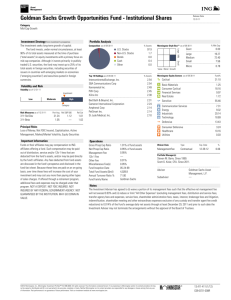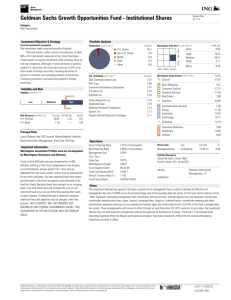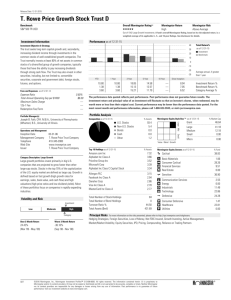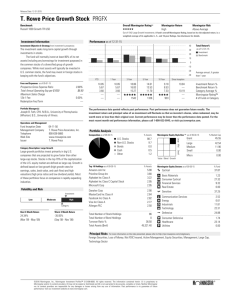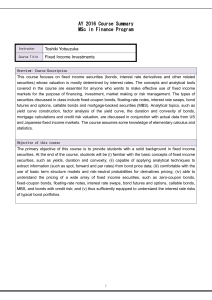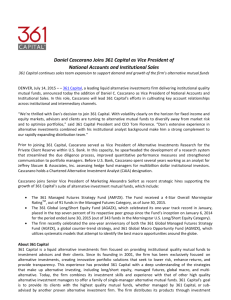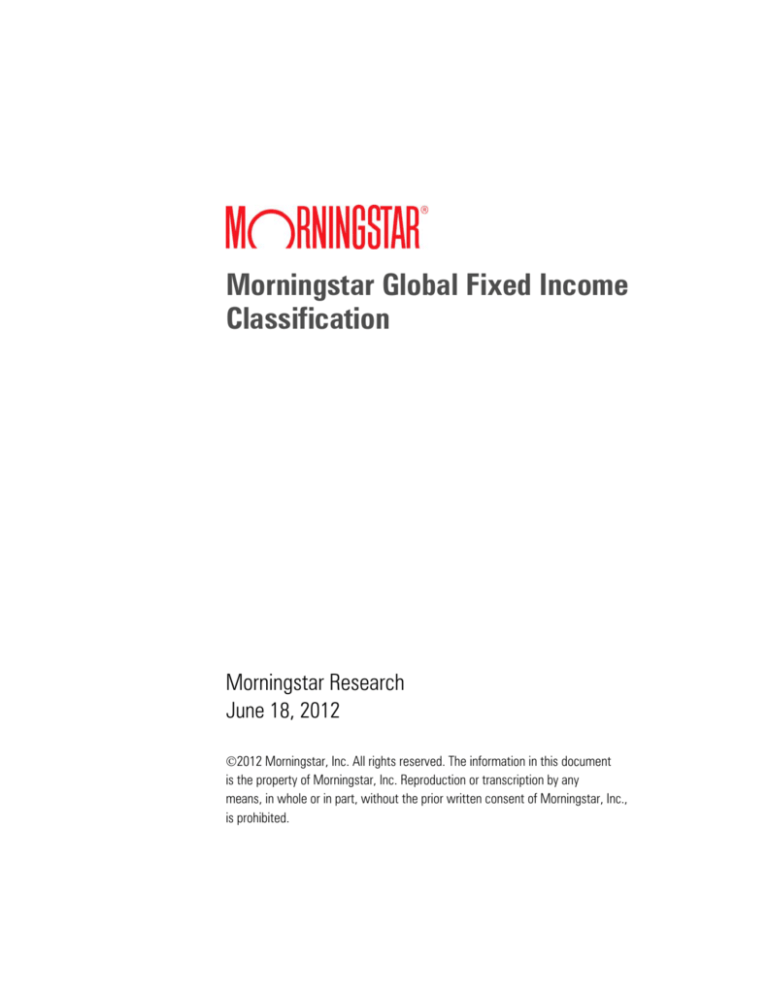
Morningstar Global Fixed Income
Classification
Morningstar Research
June 18, 2012
2012 Morningstar, Inc. All rights reserved. The information in this document
is the property of Morningstar, Inc. Reproduction or transcription by any
means, in whole or in part, without the prior written consent of Morningstar, Inc.,
is prohibited.
Contents
Introduction
3
Super Sectors
4
Sectors
12
Morningstar Global Fixed Income Classification June 18, 2012
©2012 Morningstar, Inc. All rights reserved. The information in this document is the property of Morningstar, Inc. Reproduction or
transcription by any means, in whole or in part, without the prior written consent of Morningstar, Inc. is prohibited.
2
Introduction
Fixed-Income Sectors
The fixed-income securities and fixed-income derivative exposures within a portfolio are
mapped into Secondary Sectors that represent the most granular level of classification. Each
item can also be grouped into one of several higher-level Primary Sectors, which ultimately roll
up to five fixed-income Super Sectors.
Cash Sectors
Cash securities and cash derivative exposures within a portfolio are mapped into Secondary
Sectors that represent the most granular level of classification. Each item can also be grouped
into Primary Sector Cash & Equivalents and to Super Sector Cash & Equivalents (Primary Sector
Cash & Equivalents = Super Sector Cash & Equivalents).
Morningstar felt it was important to include cash in the fixed-income sectors. Cash is not a
bond, but it is a type of fixed-income. When bond fund managers are feeling nervous about
interest rates rising they might increase their cash stake to shorten the portfolio’s duration.
Moving assets into cash is a defensive strategy for interest rate risk. In addition, Morningstar
includes securities that mature in less than one year in the definition of cash. The Cash &
Equivalents Secondary Sectors allow for more detailed identification of Cash, allowing clients to
see, for example, if the cash holdings are in Currency or short-term Government Bonds.
These classifications can help investors and investment professionals easily compare and
understand the sector exposures of each portfolio. The data is especially useful for comparing
two investments that may be in the same Morningstar category.
Cash and fixed-income sectors are calculated for all portfolios. Morningstar products may set
allocation thresholds to determine whether to display cash and fixed-income sectors for a
portfolio. Morningstar cash and fixed-income sectors will always be available for dedicated
bond funds and those with significant bond exposure, such as allocation funds. Sector
breakdowns are based on the cash and fixed-income securities and related derivatives in the
most recently available portfolio.
Morningstar Global Fixed Income Classification June 18, 2012
©2012 Morningstar, Inc. All rights reserved. The information in this document is the property of Morningstar, Inc. Reproduction or
transcription by any means, in whole or in part, without the prior written consent of Morningstar, Inc. is prohibited.
3
Super Sectors
Primary Sectors are consolidated into six Super Sectors: Government, Municipal, Corporate,
Securitized, Cash & Equivalents and Derivatives. These Super Sectors are a broader
representation of Morningstar sectors.
10 Government
1010 Government
1020 Government Related
20 Municipal
2010 Municipal Taxable
2020 Municipal Tax-Exempt
30 Corporate
3010 Bank Loan
3020 Convertible
3030 Corporate Bond
3040 Preferred Stock
40 Securitized
4010 Agency Mortgage-Backed
4020 Non-Agency Residential Mortgage-Backed
4030 Commercial Mortgage-Backed
4040 Covered Bond
4050 Asset-Backed
50 Cash & Equivalents
5010 Cash & Equivalents
60 Derivatives (Other)
6010 Swap
6020 Future/Forward
6030 Option/Warrant
Morningstar Global Fixed Income Classification June 18, 2012
©2012 Morningstar, Inc. All rights reserved. The information in this document is the property of Morningstar, Inc. Reproduction or
transcription by any means, in whole or in part, without the prior written consent of Morningstar, Inc. is prohibited.
4
Super Sectors
Government
This Super Sector includes all conventional debt issued by governments, bonds issued by a
Central Bank or Treasury, and bonds issued by local governments, cantons, regions and
provinces.
Municipal
The Municipal Super Sector includes taxable and tax-exempt debt obligations issued under the
auspices of states, cities, counties, provinces, and other non-federal government entities.
Corporate
This Super Sector includes bank loans, convertible bonds, conventional debt securities issued
by corporations, and preferred stock.
Securitized
The Securitized Super Sector includes all types of mortgage-backed securities, covered bonds
and asset-backed securities.
Cash & Equivalents
This Super Sector includes cash in the bank, certificates of deposit, currency, and money
market holdings. Cash can also be any fixed-income securities that mature in less than 12
months. This Super Sector also includes commercial paper and any repurchase agreements
held by the fund.
Derivatives
The Derivatives Super Sector includes the common types of fixed-income derivative contracts:
futures and forwards, options and swaps. For display purposes products may elect to identify
this sector as Other.
Morningstar Global Fixed Income Classification June 18, 2012
©2012 Morningstar, Inc. All rights reserved. The information in this document is the property of Morningstar, Inc. Reproduction or
transcription by any means, in whole or in part, without the prior written consent of Morningstar, Inc. is prohibited.
5
Government
Government
This Primary Sector includes all conventional debt issued by governments, including bonds
issued by a Central Bank or Treasury and bonds issued by local governments, cantons, regions
and provinces. Securities in this sector include US Treasury: inflation-protected instruments and
sovereign bonds such as German Bundesobligationen, UK index-linked Gilts and Japanese
government securities.
Government Related
This Primary Sector includes debt obligations issued by government agencies as well as
interest-rate swaps and Treasury futures that are generally considered to have a risk profile
commensurate with government bonds but may not have explicit government backing. Bonds
issued by government-sponsored enterprises such as Federal National Mortgage Association
and Federal Home Loan Mortgage Corporation can be found in this Primary Sector, while
securities backed by mortgages that carry guarantees from government agencies can be found
in the agency mortgage backed Primary Sector. Securities in this sector include U.S. bonds
issued by the Export Import Bank of the United States, The Tennessee Valley Authority, the
Commodity Credit Corporation, and the Small Business Administration as well as Treasury
futures. This Primary Sector also includes bonds issued by agencies of central governments and
bonds issued by supranational agencies. Securities in this Primary Sector include:
Bundesschatzanweisungen (German federal notes) and Australian bonds issued by electrical
suppliers and backed by the commonwealth of Australia; securities issued by the International
Bank for Reconstruction and Development (World Bank), the European Investment Bank, the
Inter-American Development Bank, and more.
Morningstar Global Fixed Income Classification June 18, 2012
©2012 Morningstar, Inc. All rights reserved. The information in this document is the property of Morningstar, Inc. Reproduction or
transcription by any means, in whole or in part, without the prior written consent of Morningstar, Inc. is prohibited.
6
Municipal
Municipal Taxable
United States regulations require that bonds benefiting from a federal tax exemption be issued
only for certain purposes. The interest on municipal bonds may be taxable (that is, not excluded
from gross income for federal income tax purposes) if they are deemed to be issued in support
of certain private activities. A municipal security is considered a private-activity bond if it meets
either of two sets of conditions set out in Section 141 of the Internal Revenue Code, which
includes limits on the use of bond proceeds for private business use. The interest from so-called
qualified private-activity bonds may be excluded from gross income for federal income tax
purposes, but it remains subject to the Alternative Minimum Tax. These "AMT bonds" are
included in the Municipal Tax-Exempt Primary Sector. This sector also includes Build America
Bonds, which were issued under the 2009 American Recovery and Reinvestment Act, and nonU.S. municipal bonds.
Municipal Tax-Exempt
Local governments, state governments, provinces, and regional authorities are often referred to
more generally as "municipalities" and typically issue bonds in order to raise money for
operations and development. This financing is sometimes used to build or upgrade hospitals,
sewer systems, schools, housing, stadiums, or industrial complexes. Some municipal bonds are
backed by the issuing entity, while others are linked to a revenue stream, such as from a toll
way or a utility. Municipal bonds in the United States are typically exempt from federal taxes
and often the taxes of the states in which they are issued. Those taxation advantages may
allow municipal governments to sell bonds at lower interest rates than those offered by
comparable taxable bonds. This Primary Sector includes issues that are subject to the
Alternative Minimum Tax but not other federal taxes.
Morningstar Global Fixed Income Classification June 18, 2012
©2012 Morningstar, Inc. All rights reserved. The information in this document is the property of Morningstar, Inc. Reproduction or
transcription by any means, in whole or in part, without the prior written consent of Morningstar, Inc. is prohibited.
7
Corporate
Bank Loan
The bank loans most commonly held within investment portfolios are typically referred to as
leveraged loans, because the balance sheets of their borrowers carry heavy debt burdens.
Loans of this kind are: normally issued with interest payments that float above a commonly
used short-term benchmark such as the London Interbank Offered Rate, or LIBOR, by at least
300 basis points; typically senior to nearly all other debt and equity in a company's capital
structure; and very often secured by specific assets or cash flows.
Convertible
Convertible bonds give their owners an opportunity to convert each security to a certain number
of shares of common stock at a certain price. As the stock approaches that price, the option to
convert becomes more valuable and the price of the convertible also rises. These securities
usually provide lower interest payments because the option to convert to stock could
potentially be quite valuable at some point in the future.
Corporate Bond
This sector includes all conventional debt securities that are issued by corporations. Corporate
bonds are issued with a wide range of coupon rates and maturity dates.
Preferred Stock
Preferred stock is legally structured as equity, above common equity in a company's capital
structure, but does not offer voting rights. Preferred stock often pays a fixed dividend and has
priority over common equity when an issuing company elects to pay dividends. Although
preferred stocks are not debt instruments, investors often treat them as such because of their
income payouts and higher capital-structure placement.
Morningstar Global Fixed Income Classification June 18, 2012
©2012 Morningstar, Inc. All rights reserved. The information in this document is the property of Morningstar, Inc. Reproduction or
transcription by any means, in whole or in part, without the prior written consent of Morningstar, Inc. is prohibited.
8
Securitized
Agency Mortgage-Backed
This sector contains securities that represent a claim on the cash flows associated with pools
of mortgages guaranteed by a government agency. Rolling into this sector are items such as
mortgage pass-throughs, mortgage CMOs, and mortgage ARMs. These securities are
guaranteed by Ginnie Mae, an agency of the U.S. government, or by U.S.-governmentsponsored enterprises such as Fannie Mae or Freddie Mac.
Non-Agency Residential Mortgage-Backed
Non-agency residential mortgage-backed securities are those not issued and guaranteed by
Fannie Mae, Freddie Mac, or Ginnie Mae. Conforming loan size limits set by the U.S.
government determine if a mortgage loan can qualify for an agency guarantee, and those that
do not qualify make up the bulk of non-agency RMBS collateral. Because they lack a third-party
guarantee, protection in the case of non-agency RMBS is generally provided through the
creation of subordinate securities. These are first in line to offer credit protection to the senior
most AAA rated classes and are accordingly priced at lower prices relative to AAAs, reflecting
their higher exposure to credit risk.
Commercial Mortgage-Backed
A mortgage-backed security backed by mortgages on commercial properties rather than
residential real estate.
Covered Bond
Covered bonds are securities issued by a bank and backed by either high-quality mortgage
loans or public-sector loans, which represent the "cover pool." Issuers raise assets for cover
pools by selling "covered bonds" to investors, which maintain a claim on the cover pool but also
a claim on the general assets and credit of the issuer. Part of what differentiates a cover pool
from the assets supporting a typical mortgage-backed security is that the cover pool remains
on the balance sheet of its issuer, usually a bank or special financial institution set up for this
purpose.
Asset-Backed
Asset-backed securities are based on the expected cash flows from debts such as auto loans,
credit card receivables, and computer leases among others. The cash flows for asset-backed
securities can be fixed or variable. These securities typically range in effective maturity from
two to seven years.
Morningstar Global Fixed Income Classification June 18, 2012
©2012 Morningstar, Inc. All rights reserved. The information in this document is the property of Morningstar, Inc. Reproduction or
transcription by any means, in whole or in part, without the prior written consent of Morningstar, Inc. is prohibited.
9
Cash & Equivalents
Cash & Equivalents
Cash can be cash in the bank, certificates of deposit, currency, or money market holdings. Cash
can also be any fixed-income securities that mature in less than 12 months. Cash also includes
commercial paper and any repurchase agreements held by the fund.
Morningstar Global Fixed Income Classification June 18, 2012
10
©2012 Morningstar, Inc. All rights reserved. The information in this document is the property of Morningstar, Inc. Reproduction or
transcription by any means, in whole or in part, without the prior written consent of Morningstar, Inc. is prohibited.
Derivatives
Swap
Swaps are risk-shifting, over-the-counter agreements that allow one party to trade one type of
exposure for another. Each party agrees in advance to trade one set of payments (e.g., fixed or
floating interest rates on a predetermined notional amount) for a different set of payments for a
set amount of time.
Future/Forward
By entering into a futures contract, the buyer (long position) has an obligation to purchase a
specific underlying asset at an agreed-upon price at a specific date in the future. The seller of
the futures contract takes a short position in the asset and agrees to sell it according to those
terms.
Forward contracts are very similar to futures contracts in that they also represent the obligation
to buy or sell a specific asset on a specific future date.
Option/Warrant
Options are contracts that allow the holder to profit if the price of the underlying asset moves in
a certain direction. Call options give the holder (the long position) the right, but not the
obligation, to buy an asset at a predetermined strike price and profit when the asset price is
higher than the strike price. Put options give the holder the right to sell an asset at a specific
strike price and profit when the market price of the asset is below the strike price. The parties
that write options take a short position and have the obligation to sell or buy the asset from the
long position if the option is exercised.
Warrants are a type of call option that is issued by the company, usually as part of a bond
offering.
Morningstar Global Fixed Income Classification June 18, 2012
11
©2012 Morningstar, Inc. All rights reserved. The information in this document is the property of Morningstar, Inc. Reproduction or
transcription by any means, in whole or in part, without the prior written consent of Morningstar, Inc. is prohibited.
Sectors
Sector
Government
Primary Sector
Government
Secondary Sector
Treasury
This sector includes all conventional debt issued by a
government’s Treasury (that is, it excludes inflation-protected
securities). Some examples of government debt are Treasury
bonds and Treasury notes. Treasury bills are included in the Cash
and Equivalents Super Sector because they mature in less than
12 months.
Inflation Protected
For securities domiciled in the U.S., these are referred to as TIPS,
or Treasury Inflation-Protected Securities. These bonds have
principal and coupon payments that are linked to movements in
the consumer price index. They can be used as a defensive
measure against expectations of inflation (which typically erodes
the real yield of conventional bonds). Even if inflation fears are in
check, these bonds can benefit when yields fall on traditional
Treasuries. These unique securities act very differently than fixedrate bonds, and their volatility can change over time, depending
on the level of interest rates.
For non-U.S. domiciled securities, these are often referred to as
inflation-linked bonds or linkers. In Canada these are termed real
return bund and in Britain the inflation-linked Gilt. In Australia
inflation-protected bonds are called Treasury-indexed bonds and
are capital linked to the Australian Consumer Price Index. In most
countries the consumer price index or an equivalent is used as an
inflation proxy.
Government
Related
Agency/Quasi Agency
Includes low-risk debt obligations issued by a government agency
or bonds issued by an agency of a central government.
Morningstar Global Fixed Income Classification June 18, 2012
12
©2012 Morningstar, Inc. All rights reserved. The information in this document is the property of Morningstar, Inc. Reproduction or
transcription by any means, in whole or in part, without the prior written consent of Morningstar, Inc. is prohibited.
Sectors
Sector
Primary Sector
Secondary Sector
Supranational
This sector includes bonds issued by supranational agencies,
such as the International Bank for Reconstruction and
Development [World Bank], European Investment Bank, InterAmerican Development Bank, and others.
Interest-Rate Derivative
This sector includes interest rate swaps, interest rate futures and
interest rate forwards. With an interest-rate swap, one party (the
receiver) receives a fixed rate and pays a floating rate (usually
LIBOR) to the counterparty. The receiver side of an interest-rate
swap has exposure that is like a long investment-grade bond as
well as short cash exposure, and the payer side has the opposite.
Interest rate futures are future contracts on interest rates.
Interest rate forwards are forward contracts on interest rates.
Treasury Future
By entering into a futures contract, the buyer (long position) has
an obligation to purchase a U.S. Treasury instrument at an
agreed-upon price at a specific date in the future. The seller of
the futures contract takes a short position in the asset and agrees
to deliver the instrument according to those terms.
Other
Includes government-related securities where Secondary Sector
could not be identified. Swaptions are also included in this sector.
Municipal
Municipal
Taxable
Municipal Taxable
Some municipal bonds are issued for certain purposes that are
not tax-exempt. This Primary Sector includes taxable US-issued
muni bonds, such as Build America Bonds, and non-US-issued
muni bonds. The Secondary Sectors under this Primary Sector are
the same as those under the Municipal Tax-Exempt Primary
Sector.
Municipal
Tax-Exempt
Municipal Tax-Exempt
This Primary Sector includes bonds which benefit from federal tax
exemptions. The Secondary Sectors under this Primary Sector are
the same as those under the Municipal Taxable Primary Sector.
Morningstar Global Fixed Income Classification June 18, 2012
13
©2012 Morningstar, Inc. All rights reserved. The information in this document is the property of Morningstar, Inc. Reproduction or
transcription by any means, in whole or in part, without the prior written consent of Morningstar, Inc. is prohibited.
Sectors
Sector
Primary Sector
Secondary Sector
State and Local General Obligation
These are municipal bonds issued by state governments or local
municipalities. The source of re-payment is not always specified
in advance, nor is the use of proceeds. They are sometimes
considered among the safest municipal bonds in the market
because they are backed by the taxing power of their issuer, but
may be viewed otherwise during periods of great economic
stress.
Advance Refunded
State and local issuers advance-refund municipal bonds to
refinance debt at lower costs. However, issuers cannot always
call the bonds at par immediately. So, they issue new bonds, buy
U.S. Treasury bonds with the proceeds, and place them in an
escrow account to back the "old" or advance-refunded bonds until
either their first call-date or maturity.
Tobacco
The Tobacco Secondary Sector combines both State and NonState Appropriated Tobacco. State Appropriated Tobacco--States
began issuing these municipal bonds after settling with a group of
tobacco companies. The Master Settlement Agreement requires
these companies to make ongoing payments to state
governments as compensation for smoking-related state healthcare expenditures. States issuing tobacco-backed bonds
essentially opt to take the whole payment upfront by issuing
bonds. They then pay the bonds' interest payments using
revenues from the settlement. "Appropriation-backed" means the
states have already earmarked funds to make bond payments.
They are safer than nonappropriated bonds. Non-State
Appropriated Tobacco--These bonds are backed by the same
settlement that backs state-appropriated tobacco bonds. They
carry modestly higher default risk because they aren't already
backed by state appropriations.
Morningstar Global Fixed Income Classification June 18, 2012
14
©2012 Morningstar, Inc. All rights reserved. The information in this document is the property of Morningstar, Inc. Reproduction or
transcription by any means, in whole or in part, without the prior written consent of Morningstar, Inc. is prohibited.
Sectors
Sector
Primary Sector
Secondary Sector
Education
Most of these municipal bonds fall into two groups: bonds for
local school districts and bonds for higher education. Local district
bonds finance buildings and projects to promote primary and
secondary education. They can be backed by local municipalities
or by state-level agencies. They may also include charter school
bonds. Higher education bonds are issued both by public
university systems and by private institutions. Other educationrelated bonds included projects such as public libraries.
Health
Health-related municipal bonds back assisted-living and hospice
facilities, hospital projects and equipment, and more. For
example, they finance construction of everything from new ruralarea hospitals to urban hospitals linked to larger care networks.
Housing
Housing-related municipal bonds back several types of projects.
For example, land-development bonds finance projects preparing
land, sewer, road, and other systems for either single-family
housing neighborhoods or multifamily housing complexes. These
bonds are backed by property taxes, which are usually initially
paid by developers. As residents move into completed
neighborhoods and complexes, they assume the property-tax
obligation. Other housing-related bonds finance the brick-andmortar construction of low-income government housing
developments.
Industrial
Industrial municipal bonds may be backed by local municipalities,
state governments, or even for-profit corporations. They finance a
wide variety of projects including pollution clean-up and private
activity. Similar to some housing-related bonds, private-activity
bonds may back, for example, the preparation of land that a forprofit company will use to build a new facility. Such bonds may
be initially backed by government entities before responsibility for
their repayment transfers to corporations. The interest from
private-activity bonds is typically subject to the Alternative
Minimum Tax.
Morningstar Global Fixed Income Classification June 18, 2012
15
©2012 Morningstar, Inc. All rights reserved. The information in this document is the property of Morningstar, Inc. Reproduction or
transcription by any means, in whole or in part, without the prior written consent of Morningstar, Inc. is prohibited.
Sectors
Sector
Primary Sector
Secondary Sector
Transportation
Transportation-related municipal bonds finance all sorts of
projects, including non-toll and toll-backed road, bridge, and
tunnel construction. They may also finance airport and seaport
construction, recurring maintenance of intra-county and city
public transportation systems, and more. They may be backed by
taxes, tolls, ridership fees, and more.
Water & Sewer
These municipal bonds are similar to utility-related issues. They
provide initial financing for construction of water and sewer
systems that property taxes or other income will eventually
repay.
Utilities
Utility-related municipal bonds finance construction and
maintenance of power plants, electrical grids, telephone grids,
and more. Their source of backing varies but may include property
taxes, usage fees, and more.
Miscellaneous Revenue
This category describes harder-to-categorize municipal bonds that
may finance a wide variety of projects.
Corporate
Bank Loan
Bank Loan
Rather than issuing bonds directly some corporate debt is sold
into the secondary market in the form of Bank Loans or Leveraged
Loans. The Secondary Sectors under for each of the Primary
Sectors under the Corporate Super Sector are identical.
Convertible
Convertible
Convertible bonds give their owners an opportunity to convert
each security to a certain number of shares of common stock at a
certain price. The Secondary Sectors under for each of the
Primary Sectors under the Corporate Super Sector are identical
Morningstar Global Fixed Income Classification June 18, 2012
16
©2012 Morningstar, Inc. All rights reserved. The information in this document is the property of Morningstar, Inc. Reproduction or
transcription by any means, in whole or in part, without the prior written consent of Morningstar, Inc. is prohibited.
Sectors
Sector
Primary Sector
Corporate
Bond
Secondary Sector
Corporate Bonds
This includes all conventional debt securities that are issued by
corporations. Corporate bonds are issued with a wide range of
coupon rates and maturity dates .The Secondary Sectors under
for each of the Primary Sectors under the Corporate Super Sector
are identical
Preferred
Stock
Preferred Stock
Preferred stock is legally structured as equity, above common
equity in a company's capital structure, but does not offer voting
rights. Although preferred stocks are not debt instruments,
investors often treat them as such because of their income
payouts and higher capital-structure placement. The Secondary
Sectors under for each of the Primary Sectors under the
Corporate Super Sector are identical
Basic Materials
Companies that manufacture chemicals, building materials, and
paper products. This Secondary Sector also includes companies
engaged in commodities exploration and processing.
Communication Services
Companies that provide communication services using fixed-line
networks or those that provide wireless access and services. This
Secondary Sector also includes companies that provide Internet
services such as access, navigation, and Internet-related
software.
Energy
Companies that produce or refine oil and gas, oil field services
and equipment companies, and pipeline operators. This
Secondary Sector also includes companies engaged in the mining
of coal.
Financial Services
Companies that provide financial services, which includes banks,
savings and loans, asset-management companies, credit
services, investment brokerage firms, and insurance companies.
Morningstar Global Fixed Income Classification June 18, 2012
17
©2012 Morningstar, Inc. All rights reserved. The information in this document is the property of Morningstar, Inc. Reproduction or
transcription by any means, in whole or in part, without the prior written consent of Morningstar, Inc. is prohibited.
Sectors
Sector
Primary Sector
Secondary Sector
Health-Care
This Secondary Sector includes biotechnology, pharmaceuticals,
research services, home health-care, hospitals, long-term-care
facilities, and medical equipment and supplies.
Industrials
Companies that manufacture machinery, hand-held tools, and
industrial products. This Secondary Sector also includes
aerospace and defense firms as well as companies engaged in
transportations and logistic services.
Real Estate
This sector includes mortgage companies, property management
companies, and REITs.
Utilities
Electric, gas, and water utilities. Companies in this Secondary
Sector include Electricité de France, Exelon Corporation, and
PG&E Corporation.
Unspecified
Corporate sector designation could not be determined.
Securitized
Agency
MortgageBacked
Agency Pass-Through
These are securities that represent a claim on the cash flows
associated with a pool of mortgages. Pass-through bondholders
are entitled to a pro-rata share of the principal and interest
payments paid by the homeowners. The timely payment of
principal and interest for agency pass-through securities is
guaranteed by government agencies. The underlying collateral of
bonds in this Secondary Sector are fixed-rate mortgages; bonds
backed by adjustable-rate mortgages are included in the Agency
ARM Secondary Sector.
Agency ARM
Agency adjustable-rate mortgages are securities that are backed
by residential home mortgages where the interest rate is reset
periodically in relation to a benchmark. The timely payment of
interest and principal is guaranteed by a government agency.
Morningstar Global Fixed Income Classification June 18, 2012
18
©2012 Morningstar, Inc. All rights reserved. The information in this document is the property of Morningstar, Inc. Reproduction or
transcription by any means, in whole or in part, without the prior written consent of Morningstar, Inc. is prohibited.
Sectors
Sector
`
Primary Sector
Secondary Sector
Agency CMO
Agency-backed collateralized mortgage obligations are backed by
pools of mortgage pass-throughs (or a pool of mortgage loans)
whose underlying cash flows are guaranteed by a government
agency such as Ginnie Mae, Fannie Mae, or Freddie Mac. They
are structured into several classes of securities (known as
tranches) with varying maturities and rules for the distribution of
principal and interest payments from the underlying collateral.
Each tranche typically has a different degree of prepayment and
interest-rate risk. Generally the goal is to create a series of
tranches that can offer greater stability or predictability of cash
flows over a wide range of prepayment speeds. Investors in
search of those traits are typically willing to accept lower yields in
exchange, while other tranches in the structure normally offer
higher yields as compensation for taking on the risks eliminated
from the more predictable tranches. There are several ways to
structure CMOs, resulting in a variety of tranche names that are
not always present in each CMO. There are other factors that
may make an individual tranche of an individual CMO act
differently than others with similar names, but under normal
conditions those labeled as sequentials, PACs, and VADMs, for
example, are considered relatively safe or stable, while others
such as IOs, POs, inverse floaters, and Z bonds are normally
expected to offer significantly higher potential returns and
volatility.
Unspecified
Securities that are identifiable as agency mortgage-backed, but
further classification could not be determined.
Morningstar Global Fixed Income Classification June 18, 2012
19
©2012 Morningstar, Inc. All rights reserved. The information in this document is the property of Morningstar, Inc. Reproduction or
transcription by any means, in whole or in part, without the prior written consent of Morningstar, Inc. is prohibited.
Sectors
Sectors
Primary Sector
Non-Agency
Residential
MortgageBacked
Secondary Sector
Non-Agency Residential Mortgage-Backed
Non-agency residential mortgage-backed securities are those not
issued and guaranteed by Fannie Mae, Freddie Mac, or Ginnie
Mae. Conforming loan size limits set by the U.S. government
determine if a mortgage loan can qualify for an agency guarantee,
and those that do not qualify make up the bulk of non-agency
RMBS collateral. Because they lack a third-party guarantee,
protection in the case of non-agency RMBS is generally provided
through the creation of subordinate securities. These are first in
line to offer credit protection to the senior-most AAA rated
classes and are accordingly priced at lower prices relative to
AAAs, reflecting their higher exposure to credit risk.
Commercial
MortgageBacked
Commercial Mortgage-Backed
Covered Bond
Covered Bonds
A type of mortgage-backed security backed by mortgages on
commercial rather than residential real estate.
Issuers raise assets for cover pools by selling "covered bonds" to
investors, which maintain a claim on the cover pool, but also a
claim on the general assets and credit of the issuer. Part of what
differentiates a cover pool from the assets supporting a typical
mortgage-backed security is that the cover pool remains on the
balance sheet of its issuer, usually a bank or special financial
institution set up for this purpose.
Asset-Backed
Auto
These issues are backed by automobiles, including auto leases,
auto receivables, and motorcycle sales contracts.
CBO/CDO
Collateralized bond obligations and collateralized debt obligations
are structured asset-backed securities. The underlying assets
often carry high default risk; CBOs and CDOs are intended to
mitigate this risk through securitization.
Morningstar Global Fixed Income Classification June 18, 2012
20
©2012 Morningstar, Inc. All rights reserved. The information in this document is the property of Morningstar, Inc. Reproduction or
transcription by any means, in whole or in part, without the prior written consent of Morningstar, Inc. is prohibited.
Sectors
Sector
Primary Sector
Secondary Sector
Credit Card
Credit card issuers, such as banks, issue asset-backed securities
whose collateral is the amount that cardholders must pay to
repay their credit card debt.
Home Equity
These ABS are backed by home equity loans. Unlike mortgagebacked securities, home equity loans are typically second-lien
debts that are junior to a primary mortgage.
Student Loan
These asset-backed securities have student loan repayments as
their collateral.
Other
These are unidentified asset-backed securities and those that do
not fit into one of the categories specified above.
Cash & Equivalents
Cash &
Equivalents
ABS
See definition of asset-backed securities above. These are
securities with maturity in less than one year.
Cash
Includes cash denominated in the base currency of the fund.
Cash Collateral
Cash collateral is non-discretionary. Certain mutual funds are
required to hold segregated cash collateral against short
positions. These are not offsets against derivatives contracts and
should be treated separately.
Commercial Paper
Low-risk debt instruments with short-term maturity dates issued
by nonfinancial corporations and other borrowers to meet shortterm financing needs.
Corporate
See definition of Corporate Super Sector above. These are
securities with maturity in less than one year.
Morningstar Global Fixed Income Classification June 18, 2012
21
©2012 Morningstar, Inc. All rights reserved. The information in this document is the property of Morningstar, Inc. Reproduction or
transcription by any means, in whole or in part, without the prior written consent of Morningstar, Inc. is prohibited.
Sectors
Sector
Primary Sector
Secondary Sector
Currency
Includes cash denominated in currency that is not the fund’s base
currency as well as short-term currency future contracts.
Derivative Cash Offset
Derivative contracts legally obligate the seller and/or the buyer of
the contract to transact in the underlying instrument at the
predetermined price and time. The legal liability (or asset)
associated with this obligation is recorded as the cash offset. For
a futures contract, Morningstar records three positions, the long
exposure embedded in the contract at full market value, the long
cash collateral and accumulated gains held by the central
clearinghouse, and short cash offset equal to the notional value of
the contract.
Floating-Rate Note
Floating-rate notes are bonds that have variable interest rates.
The variable rates are equal to a money market reference rate
such as the federal-funds rate or LIBOR plus a spread that
remains constant. These are securities with maturities of less
than one year.
Government
Includes Treasury bills, and short-term debt obligations backed by
governments with maturities of less than one year.
GSE/Agency
See Agency definition above. These are securities with maturities
of less than one year.
MBS
See Mortgage-Backed Securities definition above. These are
securities with maturities of less than one year.
Morningstar Global Fixed Income Classification June 18, 2012
22
©2012 Morningstar, Inc. All rights reserved. The information in this document is the property of Morningstar, Inc. Reproduction or
transcription by any means, in whole or in part, without the prior written consent of Morningstar, Inc. is prohibited.
Sectors
Sector
Primary Sector
Secondary Sector
Money Market
These are investments in money market funds designed to
provide a level of current income that is consistent with the
preservation of capital. These are securities with maturity of less
than one year.
Municipal
See Municipal definition above. These are securities with maturity
of less than one year.
Repurchase Agreement
A form of short-term borrowing where two parties have an
agreement where one party sells a security at a specified price
with a commitment to buy the security back at a later date. Most
repurchase agreements are overnight transactions.
TD/CD
A time deposit is an interest-bearing deposit at a savings
institution that has specific maturity. A certificate of deposit
represents a fixed-income debt security, usually issued by
chartered banks. The minimum deposit is usually $1,000, and the
maturity terms can vary from short term to several years.
Other
Includes securities with a maturity of less than one year not listed
in one of the secondary sectors above.
Derivatives
Swap
Credit Default Swap
In these agreements, one party pays fees (that are analogous to
insurance premiums) to the other party in return for gaining
protection against a default on bonds from a third company or
entity. If the reference entity does default, the party selling
protection must reimburse the party buying protection with the
difference between the par value and the post-default market
value of the reference entity's bonds.
Morningstar Global Fixed Income Classification June 18, 2012
23
©2012 Morningstar, Inc. All rights reserved. The information in this document is the property of Morningstar, Inc. Reproduction or
transcription by any means, in whole or in part, without the prior written consent of Morningstar, Inc. is prohibited.
Sectors
Sector
Primary Sector
Secondary Sector
Total Return Swap
These are commonly used to gain exposure to a bond that the
fund does not own. The fund pays a floating rate and receives the
income and capital gains from the bond in return. This provides
the fund with long exposure to the reference bond and short
exposure to cash.
Debt Swap
A debt swap is a series of transactions where debts or
receivables are exchanged between two entities.
Future/
Forward
Bond Future
These are futures contracts on specific bond issues, generally
corporate bonds.
Currency Forward/Future
These are future and forward contracts on currencies.
Bond Unit
Bond units are units where the underlying security is the issuer’s
debt.
Option/
Warrant
Bond - Option
Options are contracts that allow the holder to profit if the price of
the underlying asset moves in a certain direction. Call options
give the holder (the long position) the right, but not the obligation,
to buy an asset at a predetermined strike price and profit when
the asset price is higher than the strike price. Put options give the
holder the right to sell an asset at a specific strike price and profit
when the market price of the asset is below the strike price. The
parties that write options take a short position and have the
obligation to sell or buy the asset from the long position if the
option is exercised. Options can be used for speculation or for
hedging. Bond index options are included in this sector.
Bond - Warrant/Right
Warrants or rights function in a similar way as options, except
they are sold attached to the issuance of a stock or bond. The
Fixed Income Classification Structure only includes warrants and
rights attached to bonds. After initial issuing, they can be
detached and traded in the market with their own market values.
Morningstar Global Fixed Income Classification June 18, 2012
24
©2012 Morningstar, Inc. All rights reserved. The information in this document is the property of Morningstar, Inc. Reproduction or
transcription by any means, in whole or in part, without the prior written consent of Morningstar, Inc. is prohibited.

